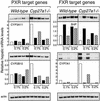Identification of bile acid precursors as endogenous ligands for the nuclear xenobiotic pregnane X receptor
- PMID: 12509506
- PMCID: PMC140933
- DOI: 10.1073/pnas.0237082100
Identification of bile acid precursors as endogenous ligands for the nuclear xenobiotic pregnane X receptor
Abstract
Sterol 27-hydroxylase (CYP27A1) is required for bile acid synthesis by both the classical and alternate pathways. Cyp27a1(-/-) mice exhibit a dramatic increase in the activity of cytochrome P450 3A (CYP3A), which catalyzes side-chain hydroxylations of bile acid intermediates, thereby facilitating their excretion in the bile and urine. We examine the role of the nuclear xenobiotic receptor PXR (pregnane X receptor) in this process. We demonstrate that expression of Cyp3a11 and other established PXR target genes is increased in the Cyp27a1(-/-) mice. WhenCyp27a1(-/-) mice are fed a diet containing either cholic acid or chenodeoxycholic acid, expression of CYP7A1, which catalyzes the rate-limiting step in bile acid biosynthesis, is strongly suppressed. In parallel, the induction of Cyp3a11 observed in these mice is reversed, suggesting that bile acid intermediates serve as PXR activators. In support of this hypothesis, three potentially toxic sterols (7alpha-hydroxy-4-cholesten-3-one, 5beta-cholestan-3alpha,7alpha,12alpha-triol, and 4-cholesten-3-one), including two that are known to accumulate in Cyp27a1(-/-) mice, are efficacious activators of mouse PXR. All three compounds are more potent activators of mouse PXR than of human PXR, which may explain in part why humans who lack functional CYP27A1 do not display a corresponding increase in CYP3A activity and are stricken with the disease cerebrotendinous xanthomatosis. Taken together, these results reveal the existence of a feedforward regulatory loop by which potentially toxic bile acid intermediates activate PXR and induce their own metabolism. In addition, this study demonstrates that animal models with alterations in gene expression can be used to identify endogenous ligands for orphan nuclear receptors.
Figures





References
-
- Björkhem I, Leitersdorf E. Trends Endocrinol Metab. 2000;11:180–183. - PubMed
-
- Björkhem I, Boberg K M, Leitersdorf E. In: The Metabolic and Molecular Bases of Inherited Disease. Scriver C R, Beaudet A L, Sly W S, Valle D, editors. New York: McGraw–Hill; 2001. pp. 2961–2988.
-
- Salen G, Shefer S, Berginer V M. In: Metabolic Basis of Inherited Disease. Stanbury J B, Wyngaarden J B, Fredrickson D S, Brown M S, Goldstein J L, editors. New York: McGraw–Hill; 1981. pp. 713–730.
-
- Rosen H, Reshef A, Maeda N, Lippoldt A, Shpizen S, Triger L, Eggertsen G, Björkhem I, Leitersdorf E. J Biol Chem. 1998;273:14805–14812. - PubMed
Publication types
MeSH terms
Substances
LinkOut - more resources
Full Text Sources
Other Literature Sources
Medical
Molecular Biology Databases

